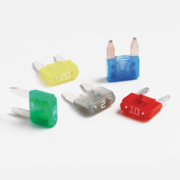Fuse Sizes
Here’s the answer to another popular question that we get from customers when they’re wiring their cars with our Infinitybox wiring system.
What size fuse should they use for the different outputs on the POWERCELL?
Remember why the fuse is there… it is there to protect the wire not the end load. There is no need to protect the headlamp with a fuse but you do need to protect the wire going to the headlamp. A fuse is a thermally operating device that is intended to be the weakest point in an electrical system. If the system is drawing too much current, you want the fuse to open intentionally, protecting the rest of the system. You never want your wire to be the weakest point in your electrical system.
Fuses are designed to protect against two kinds of faults. The most common is a short circuit. Let’s say that the wire to your headlights gets pinched against the chassis and breaks the insulation. You now have a very low resistance path to ground which will carry a lot of current. You want the fuse to open before the insulation on the wire gets hot enough to cause damage. The other scenario is a low-overload. These are usually resistive connections to ground that will still carry enough current to damage the wire.
To properly select the size of the fuse that you need to consider two things.
First, what is the minimum gauge of wire that the fuse needs to protect? All of the output harnesses on the Infinitybox POWERCELLs use 14-AWG wire. But, if you spice our output wire to a wire with a smaller gauge, you need to size the fuse to protect the smaller wire.
Second, you must understand the current draw for your load connected to the output wire. The fuse must be large enough to handle the steady-state current of the load plus any inrush that the load may have. Anything inductive (motors, coils, solenoids, etc) have inductive inrushes that could be up to 10 times the steady-state current draw. Incandescent bulbs also have inrushes. Remember that the resistance of the filament in the bulb is a function of its temperature. When the bulb is cold, the resistance is low so it can carry more current. As the filament heats up, the resistance increases as does the current flowing through the bulb. The inrush through a light bulb can be 5 to 10 times its steady state current.
For those who want to learn more, this link will take you to a good document from Littelfuse that talks about how to properly size a fuse for a specific application.
LED lights draw far less current than their incandescent brothers and have practically no inrush. You can use a much smaller fuse.
Here is a simple chart to use as a reference for sizing your fuses.
Headlights- 20-amp
Starter solenoid- 20-amp
Ignition- 25-amp
Fuel pump- 25-amp
High-Beams- 20-amp
Turn-signals- 15-amp
Cooling fan- 25-amp
Power window regulator- 20-amp
Lock actuator- 15-amp
Parking lights- 15-amp
Horn- 10-amp
Use this chart as a guideline to pick your fuse sizes. You may need to adjust depending on the gauge of wire connected to your load and the specifics of your load. Remember, these are guidelines. If you change the gauge of wire that is included in the kit, you have to reevaluate the size of fuse required.
Contact our technical support group at (847) 232-1991 for more details.

